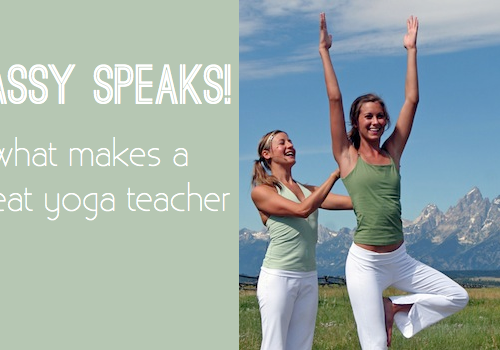I recently decided that someday I would like yoga instructor and writer to become my two professions. I’d even be willing to give up my six years of university and two degrees to do something that I love instead. By my writing this article I am working on the latter, but becoming a yoga instructor takes time, effort, money, and flexibility (of which I have none at the moment). Becoming a good, great, or even spectacular yoga instructor takes more than the usual suspects though; it takes heart, soul, and a good public speaking voice (of which, I’d like to think I have all three).
In my eight years of yoga experience, I have had nearly twenty different teachers, all with their own set of rules, instructions, and teaching methods. And through all of these instructors, I have learned a great deal of things, not only about yoga, but also about what makes an effective, compassionate, and helpful yoga teacher:
1. Be prepared!
Students know when the instructors haven’t made notes in advance because ‘um, uhh, and what should I do next?’ come out of their mouths a little too often! I have had a few teachers reading notes or books before class making sure they’re prepared for the next hour and I appreciate the efforts they put into their instruction.
2. Don’t be too repetitive
I find myself saying my own catchphrases all the time, but when the yoga instructor says ‘amazing’ or ‘cool’ or ‘slowly’ with every sentence they say, students catch onto it. Recently I had an instructor say, “Put your nipple to your knee” at least 4 times in an hour… talk about awkward! Also, teachers should try not to repeat routines or specific poses too often in their different classes. Some yogis attend class often and like variety.
3. Remember that everyone in the room is listening to every word you say
Yoga instructors aren’t politicians, so they don’t need to memorise scripts, but they should speak from the heart and with passion about what they know and what they practice. As a student lying with my eyes closed, I can always tell when a teacher is reading straight from a book instead of with their genuine heartfelt beliefs. Students want a public speaker, not a public reader.
4. Stay focused
It is easy to get distracted in a room full of people, but when I am in pigeon pose, I do not want to hear about how the teacher’s dog ran away and she had to call every neighbor within a five-mile radius. Many of my instructors make yoga jokes to lighten the mood and a chuckle here and there is always welcome, but when I am about to cry from pain, pay attention please!
5. Always walk around the room and help
Yin yoga is an almost impossible feat for me with my inflexible hips, so I am always grateful for bits and pieces of help from the teacher, a foot placement, a more comfortable position, or a push further for a bigger stretch. The instructor is the “expert” in the room, so students trust that he or she knows best and is willing to help, especially when we don’t know that we need it.
It may take many years for my dream of being a yoga instructor to come into fruition. When the time does come, I would like to think that my many yoga classes and multiple instructors will keep me keen on the needs and wants of my students and I can bet that the aforementioned are on many students’ lists.
What’s your criteria for a great yoga instructor? Share your stories… good or bad… in the comments below!






 Eat & Drink
Eat & Drink



 Travel
Travel



 Style
Style



 Beauty
Beauty



 Health & Wellness
Health & Wellness



 Home & Decor
Home & Decor



 Lifestyle
Lifestyle
 Weddings
Weddings






